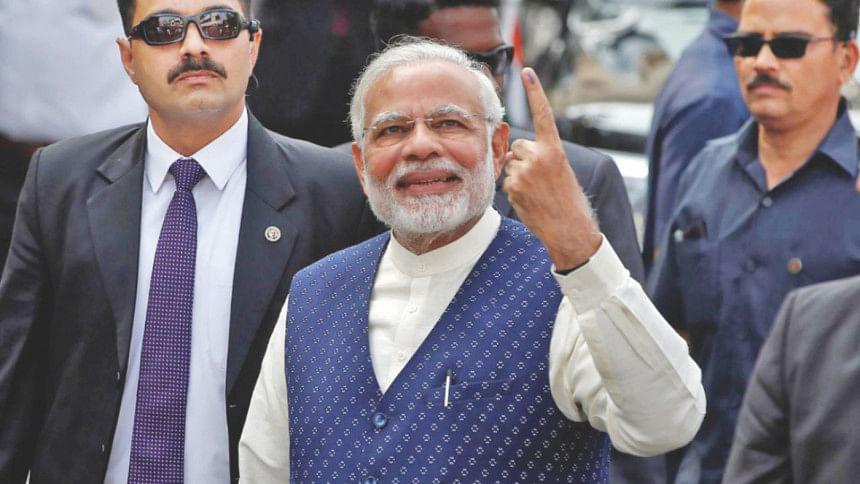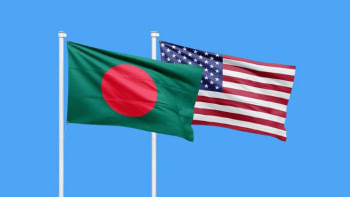Gujarat scare for BJP

Two important state legislative elections were held in India recently. Gujarat went for elections on December 9 and 14, and Himachal Pradesh elections were held on December 9, 2017.
As counting began on December 18, all eyes were focused on Gujarat, well known for communal riots. The 1985 riots helped BJP's rise in the state. It is the home state of Narendra Modi from where he rose to become prime minister in 2014, despite being severely criticised for the riots of 2002 that cost nearly 2,000 lives. Gujarat is considered a political battle ground and BJP's performance not only measured the party's popularity but also its prospects for the next Lok Sabha election in 2019.
As the preliminary results started to trickle in there were clear visible signs of panic and anxiety among BJP leaders that they may lose majority. However, results show that BJP crossed the majority threshold of 92 and got 99 seats in the 182-seat state legislative assembly. However, compared to the results of 2012, BJP lost 19 seats. Indian National Congress (INC) improved its tally to 80 seats (61 seats in 2012). In cricketing jargon, BJP became victim of nervous 90s. Indeed it was a poor show when BJP claimed to cross 150 seats before the elections. This is the sixth term in a row that BJP has won Gujarat elections since 1995. For Congress it was the seventh defeat in succession since 1990.
In Himachal Pradesh BJP has ousted Congress. In the 68-seat Himachal assembly (majority 35 seats) BJP gained 44 seats (26 seats in 2012) compared to 21 seats of Congress (36 seats in 2012). The irony is that BJP's Chief Minister candidate PK Dhumal lost the election.
This election came just when Rahul Gandhi was in the process of taking over Congress leadership from his mother Sonia Gandhi, who led the party for 19 years. He took over as President of Congress on December 16. The change of guard from among the Nehru dynasty came at a time when Congress has been in the doldrums. Many hoped that as president of the party Rahul Gandhi will change Congress's fortune.
Psephologists have identified several factors that have been at work for Congress's gains and BJP's losses. First, the Electronic Voting Machines used in this election had the provision for "None Of The Above" (NOTA)—the negative vote. Out of 68.41 percent casting their vote, two percent voted NOTA. Second, financial policies of BJP backfired in Gujarat, dominated by the business class. Modi's demonetisation of November 2016 had damaged the rural economy of India. Later the Modi government introduced the "Goods and Services Tax" (GST) on July 1, 2017, which is widely resented by consumers. Third, the caste factor played against the BJP. In Gujarat OBC, Adivasis and Dalits together constitute 62.5 percent of voters, compared to 37.5 percent of forward caste, Muslims and others. In the 1980s Congress created a vote bank by uniting the Kshatriya, Harijan, Adivasi and Muslims (KHAM). The KHAM strategy was an extension of the pro-poor programme of Congress government. This time Congress tried to use KHAM through Hardik Patel, a young Indian social and political activist. Hardik organised the lower castes Patidars (poor land-owning community) and the Patels (village leaders) to vote for Congress—that lifted the results for Congress. Fourth, religion became an issue in the election. BJP brought Hinduism into the political discourse wrapped in the slogan of "vikas". Naturally, BJP did not field any Muslim candidate in this election. Meanwhile Rahul Gandhi's secularism also came under criticism. Fifth, the anti-incumbency factor worked against BJP. While there was 10 percent increase in women voters turning out for Congress, there was a drop of eight percent for the BJP. In urban areas BJP did better than Congress. Congress got more seats in rural districts. Finally, BJP played majoritarian politics as against Congress's inclusiveness. All these factors and many others in individual constituencies defined the political discourse and the voting pattern in Gujarat.
The campaign discourse this time was most distasteful. Campaign speeches by leaders of both parties used divisive issues of caste and religion. Personal attacks were indeed most offensive. In an interview Congress leader Mani Shankar Aiyer called Modi a "neech aadmi" (lowly person) after the prime minister accused Congress of seeking votes in BR Ambedkar's (Harijan) name. Undaunted Modi came out with a scathing attack on Congress alleging that former Prime Minister Manmohan Singh met some Pakistanis at Mani Shankar's house "secretly" to make Ahmed Patel Chief Minister of Gujarat. Ahmed Patel (a Muslim) is political Secretary of Sonia Gandhi and member of the Rajya Sabha. Mani Shankar later apologised for his remark about Modi. But Modi's allegation against Manmohan Singh has created a political uproar and deadlocked the Lok Sabha session on December 19.
Surprisingly, BJP ally, Shiv Sena, launched a sharp attack on Modi for dragging the Pakistan issue in Gujarat election and termed it an "impious" way to win the election. Shiv Sena said that if Pakistan was indeed involved then as Prime Minister, Modi should take action rather than level allegations.
Rahul Gandhi speaking on the results said Congress gave a tough fight in Gujarat that gave a massive jolt to BJP. He questioned Modi's credibility and termed Modi's "vikas" model as hollow. After the initial scare Modi and BJP Chief Amit Shah were nevertheless upbeat about retaining Gujarat and sweeping Himachal Pradesh.
In the final analysis, it is clear that it was Modi's personal victory in Gujarat and not that of BJP. The results also propped up Congress under its new president Rahul Gandhi. Interestingly, it was a bi-polar electoral duel between the BJP and the Congress. No regional party had any electoral presence in these two states. What shape of political alignments will emerge for the next Lok Sabha election in 2019 remains wide open.
Mahmood Hasan is former Ambassador and Secretary.





Comments